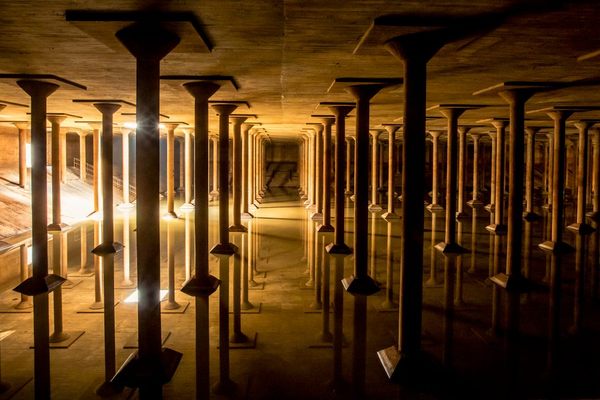The Failed Paradise: Pruitt-Igoe
Demolition of Pruitt-Igoe (via U.S. Department of Housing and Urban Development Office of Policy Development and Research)
Intended as a paradise, Pruitt-Igoe is remembered today as America’s most notorious housing project. “Modern architecture died in St Louis, Missouri on July 15, 1972, at 3.32 pm,” wrote architecture critic Charles Jencks of the Pruitt-Igoe housing projects. Completed in 1954, the 33 11-story buildings replaced entire neighborhoods of slums in inner city St. Louis and were initially advertised by the St. Louis Housing Authority as a paradise of “bright new buildings with spacious grounds,” indoor plumbing, electric lights, fresh plastered walls, and other “conveniences expected in the 20th century.”
Federal money was funneled into the project, a product of a post-war public housing program intended to revitalize downtown St. Louis in the face of rising violence and white flight. It was to be Manhattan on the Mississippi, a cure for the urban poor, swapping slums for amenities and rebuilding the city — yet not 20 years later, the buildings would be imploded by dynamite, having become an icon of failure. What went wrong?
Aerial view of Pruitt-Igoe (via United States Geological Survey)
Designed by Minoru Yamasaki and George Hellmuth in 1951, Pruitt-Igoe was to be the epitome of the modernist high-rise. Designed on 57 acres, with 2870 units, it would be a mini city of 10,000 people, with innovative skip-stop elevators, communal green spaces, and long hallways intended to foster community. The Igoe apartments were intended for whites, the Pruitt for blacks. Yet when it became clear that whites were unwilling to move into the development due to a racist unwillingness to live alongside African-Americans, it became all black, with a median income of $2,718 (the equivalent of $25,000 today).
1968 view of Pruitt-Igoe (via United States Geological Survey)
Today, the buildings are arguably the most infamous public housing project ever built in the United States, but at first it would seem they were a haven as compared to the slums, a blessing to many residents grateful for the fresh start. In The Pruitt-Igoe Myth, a 2011 film interviewing past residents on their experiences growing up in the buildings, many recall the initial joy and warmth of the place, the efficiency of the plumbing, the smells of cooking, and the community. One interviewee even recalled her apartment as a “poor man’s penthouse.” “I know a lot of bad things came out of Pruitt-Igoe,” she says in the film, “I know they did. But I don’t think they outweighed the good.”
The playground at Pruitt-Igoe (via Michael R. Allen/Flickr user)
The facilities quickly degraded. While federal money had created the projects, maintenance fees came from the tenants’ rents. As conditions grew worse, vacancies increased in a vicious cycle and funding evaporated. The resulting negligent maintenance regime meant the buildings spiraled into filth and squalor, a slum built and supported by the government. What ultimately came to be viewed as a bad design left residents subject to violent crime in the long hallways. Mice and roaches were everywhere, vandalism left so many broken windows you could see through the structures. People preferred the perpetually broken-down elevators to the murderous stairs, climbing up the shaftways when they got stuck between floors.
Corridor at Pruitt-Igoe (via Wikimedia)
Drugs, gangs, prostitution, and shootings were daily occurrences, often unreported. According to The Pruitt-Igoe Myth, the police wouldn’t even bother with calls to Pruitt-Igoe; residents on the upper stories sometimes lobbed bricks at the cop cars that did show up. In the film, one man tells of how, as a nine-year-old, he watched his mother hysterically shoving his brother’s guts back into his stomach after being shot by a sawn-off shotgun. “[Pruitt-Igoe] would be here today if it had been maintained like it was when it opened up,” says one former residents in the film, ”but it went down and down and down and down.”
Abandoned dwellings at Pruitt-Igoe (via U.S. Department of Housing and Urban Development)
In 1972, the project was labeled a failure, and the buildings were dynamited in a haunting display of literal and symbolic implosion. Minoru Yamasaki (also the designer of the World Trade Center, which went up as Pruitt-Igoe came down) did not mention the projects in his autobiography. By 1977, the last block of buildings was rubble. Today the plot is an urban forest, overgrown and sectioned off, unidentifiable from any other cleared neighborhood except to those who know what once stood there, namely the ex-residents of Pruitt-Igoe, who even from ash can summon the smells and screams of what must have been a childhood too visceral for words.
1972 demolition of Pruitt-Igoe (via U.S. Department of Housing and Urban Development)
The site of Pruitt-Igoe today (photograph by Chris Freeland)
THE REMAINS OF PRUITT-IGOE, St. Louis, Missouri








Follow us on Twitter to get the latest on the world's hidden wonders.
Like us on Facebook to get the latest on the world's hidden wonders.
Follow us on Twitter Like us on Facebook